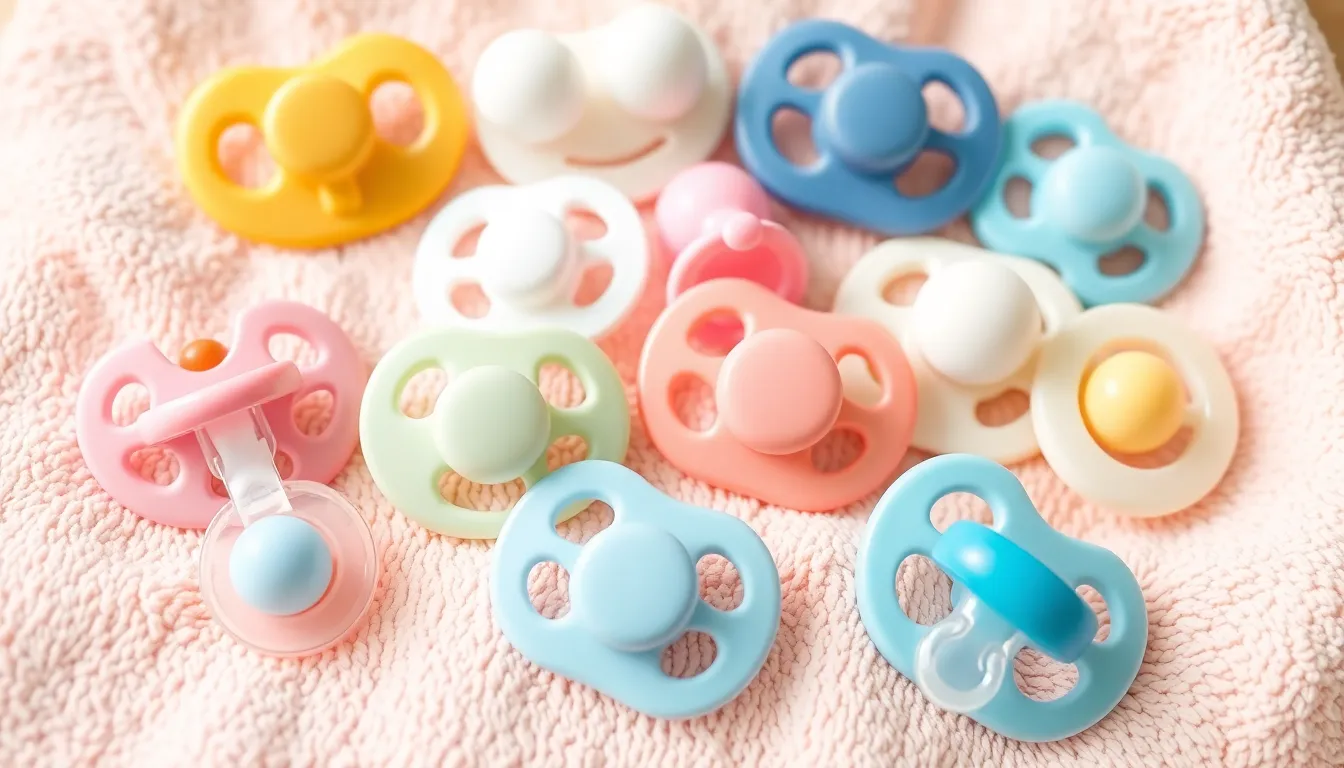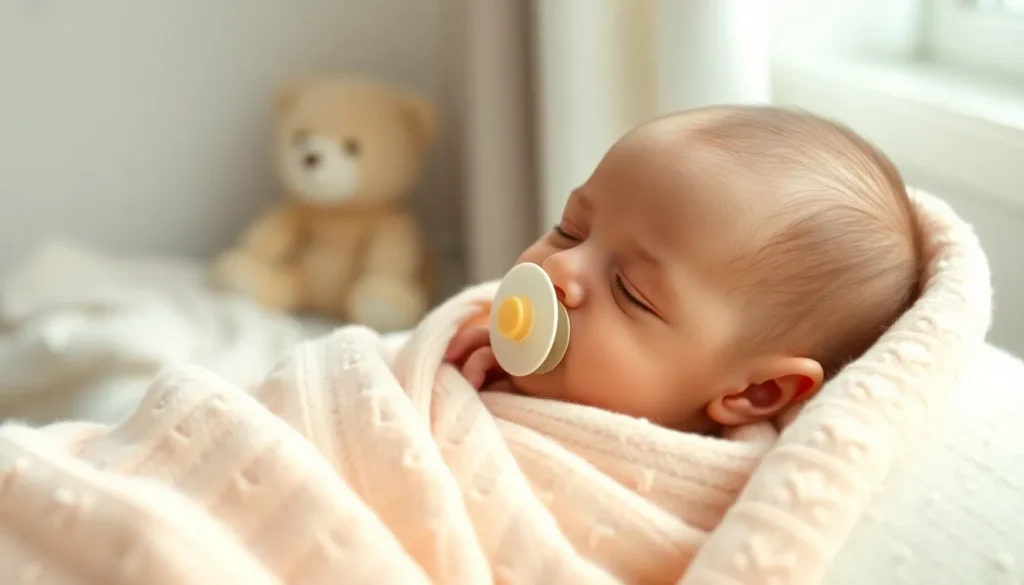Table of Contents
ToggleNewborns and pacifiers—what’s the deal with this tiny, rubbery miracle? For parents navigating the sleepless nights and endless cries, a pacifier can feel like a secret weapon. It’s the ultimate multitasker: soothing a fussy baby while giving parents a moment of peace. Who knew a little piece of plastic could hold so much power?
Understanding Newborns and Pacifiers
Pacifiers play a significant role in the lives of newborns, offering comfort and soothing effects that can alleviate fussiness. Many parents find pacifiers to be beneficial tools during the early stages of parenting.
Benefits of Pacifiers for Newborns
Pacifiers can help soothe fussy newborns effectively, providing instant comfort. Many babies find sucking on a pacifier satisfying, leading to reduced crying episodes and calmer environments. They may also assist in satisfying a newborn’s natural sucking reflex, beneficial for babies who are not breastfeeding. Dental professionals note that pacifiers can lower the risk of sudden infant death syndrome (SIDS) when used during sleep. Parents often appreciate the ease of pacifiers, making it simpler to calm their babies when needed.
Potential Risks of Pacifier Use
Pacifiers may pose some risks when used improperly or excessively. Prolonged use can lead to dental issues such as misalignment of teeth or changes in jaw development. Some infants become dependent on pacifiers, leading to difficulties in self-soothing without them. Experts caution that pacifiers might interfere with breastfeeding, especially if introduced too early, affecting latch and milk supply. Maintaining proper hygiene is essential, as dirty pacifiers can introduce harmful bacteria, causing infections. Parents should monitor pacifier usage to minimize potential negative effects on their newborns.
Choosing the Right Pacifier

Selecting a suitable pacifier can significantly affect a newborn’s comfort and parental peace of mind. Various options exist based on material, shape, and purpose.
Types of Pacifiers Available
Silicone pacifiers are common due to their durability and ease of cleaning. Rubber pacifiers provide a softer feel but may require more frequent replacement. Orthodontic pacifiers help promote healthy oral development by supporting proper tongue positioning. Some pacifiers even come with built-in toys or clips for convenience. Colors, designs, and sizes vary significantly across brands, ensuring every parent can find an appealing choice for their baby.
Key Features to Consider
Evaluating pacifiers involves examining key aspects. Size matters; ensuring fit to a newborn’s mouth is vital for comfort and effectiveness. Check for BPA-free materials to prioritize safety. A one-piece design enhances hygiene and reduces choking hazards, as it minimizes crevices where germs accumulate. Consider the shape; some pacifiers feature orthodontic designs that support healthy gum development over time. Lastly, explore options with easy-to-clean surfaces that enhance day-to-day use.
Pacifier Weaning Process
Weaning a baby from a pacifier can promote independence and healthy oral development. Many parents seek signs that indicate readiness for this transition.
Signs Your Baby is Ready to Wean
First, consider whether the baby shows less interest in the pacifier. When a newborn begins to suck on fingers or toys instead, this behavior often signals readiness. Increased verbal communication can also indicate a desire for independence from the pacifier. Observe mood changes; reduced fussiness during sleep may suggest it’s time to wean. If the baby reaches a developmental milestone, like walking or talking, they might be more prepared to let go of pacifier reliance.
Tips for a Smooth Transition
Gradual reduction of pacifier use leads to a smoother transition. Replace pacifier moments with comforting activities, such as cuddling or reading books. Choosing specific times, like bedtime, to eliminate the pacifier first can ease the process. Offer alternatives, like a special blanket or stuffed animal, to provide comfort during weaning. Lastly, positive reinforcement motivates the baby to adapt. Celebrate small victories to encourage this new phase of growth.
Alternatives to Pacifiers
Several options exist to soothe newborns without using pacifiers. One effective method is swaddling, as it gives babies a sense of security and comfort. Many parents find that gentle rocking or movement calms their fussy infants. Holding the baby close during feedings often reassures them, promoting a peaceful environment.
Some newborns respond positively to sound. White noise machines or soft music can create a soothing atmosphere, mimicking the sounds of the womb. Skin-to-skin contact provides warmth and intimacy, helping to regulate the baby’s emotions.
Another effective alternative is the use of teething rings. These can distract babies and satisfy their natural instinct to chew, particularly during teething phases. Engaging infants with visual stimuli, such as colorful toys or mobiles, can also capture their attention and reduce fussiness.
Providing a warm bath often serves as a relaxing activity for many newborns. Bath time can become a calming ritual that promotes bonding between parent and child. For some, the scent of lavender or chamomile in lotions can enhance relaxation during bedtime routines.
Parents should consider incorporating these activities alongside traditional methods to create a comforting atmosphere for their newborns. Each alternative presents unique benefits, addressing individual preferences and needs while ensuring babies feel secure and relaxed.
Navigating the world of newborns and pacifiers can be a balancing act for parents. While pacifiers offer soothing benefits and can help ease the challenges of early parenthood, awareness of their potential drawbacks is crucial. By selecting the right type and monitoring usage, parents can enhance their baby’s comfort while minimizing risks.
As they explore alternatives for soothing, parents should remember that every baby is unique. The journey of finding what works best may take time and patience. Ultimately, creating a nurturing environment filled with love and understanding will support a newborn’s development and well-being.







